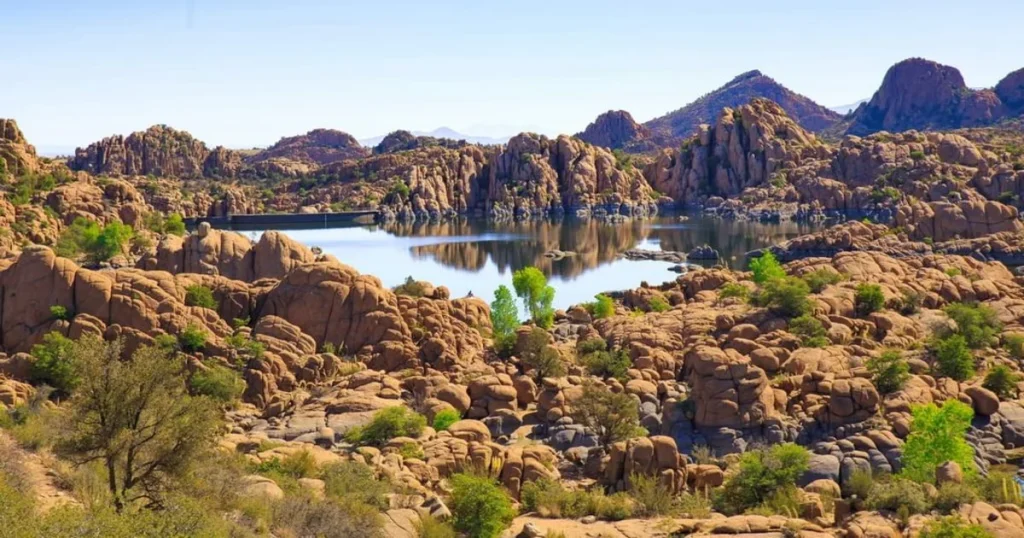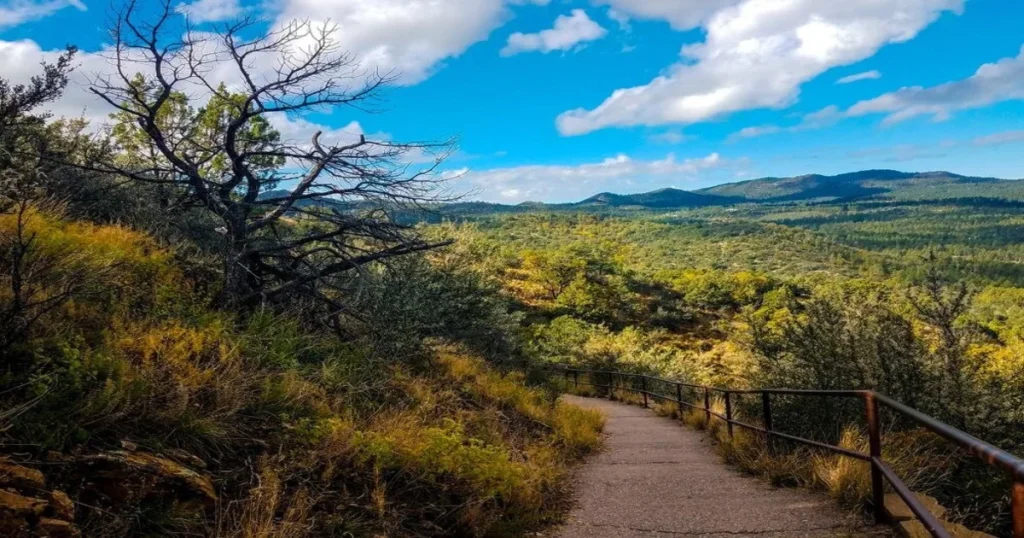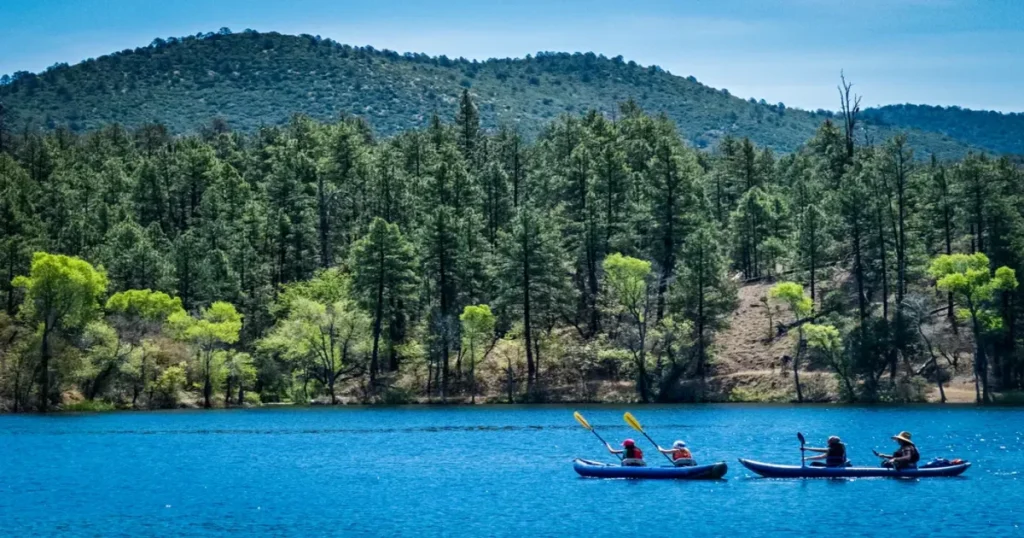The allure of Prescott National Forest is undeniable. Sprawled across central Arizona, this vast expanse offers a fascinating tapestry of landscapes, wildlife, and histories that captivate both locals and tourists. The significance of its natural landmarks can’t be overstated.

From towering granite formations to serene lakes and verdant meadows, the forest tells countless tales of nature’s wonders. Today, we’ll journey through the natural landmarks within Prescott National Forest, providing a unique window into the area’s rich biodiversity and geological marvels.
Historical Overview of the Prescott National Forest
Nestled in the heart of Arizona, the Prescott National Forest is steeped in history. A remarkable 1.25 million acres in size, it has stood as a testament to the ebb and flow of time, witnessing events that have shaped the very fabric of America.
The origins and establishment of the forest date back to the late 19th century when conservation became a priority. Recognizing the unique value of this region, the U.S. government designated it as a national forest in 1898. Since then, it’s evolved, playing host to countless natural phenomena and intertwining with human history.
Over the years, the landscape has seen significant changes. Fires, climate variations, and human intervention have all played roles in shaping what we see today. Yet, through it all, the forest’s resilience and beauty have remained a constant, making it a cherished spot for nature enthusiasts.
Geological Wonders
Prescott National Forest is a testament to the earth’s dynamic history, showcasing geological wonders sculpted over eons. The intricate dance of tectonic plates, erosion, and elemental forces has given birth to a realm of stunning rock formations, cliffs, and unique geological features.
These structures narrate tales of ancient volcanic activities, the relentless flow of water, and the winds’ persistent whispers. From jagged peaks that pierce the skyline to layered rock faces revealing epochs of sedimentation, each formation is a page in the earth’s grand chronicle.
Visitors are invited to marvel at these wonders, pondering the immense span of time and the natural processes that have molded the very ground beneath our feet.
The Mystery of the Granite Dells
The Granite Dells are an iconic feature of the Prescott region. These rounded granite formations have captivated visitors for generations with their rugged beauty.
Scientific American details that their formation is a result of erosion acting on granite bedrock over millions of years. The unique weathering process gives the Dells their characteristic appearance.
For those with a sense of adventure, the Granite Dells offer recreational opportunities galore. From rock climbing to hiking, there’s an activity for everyone. Plus, with the picturesque Watson and Willow Lakes nestled amidst them, the Dells serve as a backdrop for many a cherished memory.
The Depth and Beauty of Hell’s Hole
While the name might sound foreboding, Hell’s Hole is a place of beauty. This deep canyon, with its sheer walls and unique rock formations, offers a stark contrast to the surrounding landscape.
Its unique geological characteristics are a result of various natural processes working in tandem over millennia. According to sources like the National Geographic, erosion, sediment deposition, and tectonic activity have all played a part.
The region around Hell’s Hole boasts a rich tapestry of flora and fauna. From desert shrubs to birds of prey, it’s a biodiverse hotspot that showcases the adaptability of nature.
Majestic Water Features
Within the embrace of Prescott National Forest, water plays a transformative role, shaping landscapes and birthing awe-inspiring features. The forest’s rivers, lakes, and waterfalls stand as majestic testaments to nature’s power and elegance.

Gentle streams meander through shaded groves, their glistening waters reflecting the canopy above. Tranquil lakes, cradled by verdant banks, become mirrors of the sky, capturing clouds and sunsets in their serene depths. And then there are the waterfalls, cascading with fervor, their roars echoing through the woods, a rhythmic reminder of nature’s ceaseless vitality.
Together, these water features enrich the forest, adding layers of beauty and offering sanctuaries of peace to all who visit.
Watson and Willow Lakes
Watson and Willow Lakes stand as jewels in the crown of Prescott’s natural beauty. Originating from the region’s unique geological formations and water sources, these lakes are crucial for the ecosystem.
According to the U.S. Geological Survey, they serve multiple roles – from supporting diverse aquatic life to offering recreational spots for humans.
Activities around these lakes are many. Whether it’s boating on Watson’s placid waters or bird-watching by Willow’s shores, there’s always something to do.
Lynx Lake’s Pristine Waters
Lynx Lake is another testament to nature’s artistry. This reservoir, located amidst tall ponderosa pines, offers a serene escape.
Its creation and role in the forest are significant. The lake provides a water source for numerous species and has become a recreational hub. Arizona Highways recommends a stroll around its perimeter, where one can spot wildlife, and fish, or simply soak in the views.
Verdant Meadows and Scenic Vistas
The expansive stretch of Prescott National Forest unfolds like a visual symphony, with its verdant meadows and scenic vistas offering solace to the wandering soul. As one stroll through these lush meadows, the soft carpet of green underfoot contrasts brilliantly with the azure sky above. Wildflowers pepper the landscape, their vibrant hues dancing in the gentle breeze.
From vantage points atop rolling hills, panoramic vistas provide breathtaking views of the horizon, where the forest canopy meets the expansive sky. These spots, bathed in the golden hues of dawn or painted with the fiery colors of dusk, are nature’s canvas, showcasing the sheer beauty and tranquility of the great outdoors.
Thumb Butte’s Panoramic Views
Thumb Butte, with its distinctive silhouette, dominates Prescott’s skyline. A hike to its summit rewards with panoramic views that are simply unmatched.
Its history and significance are interwoven with local lore. Many tales, both fact and fiction, surround this iconic landmark.
For the avid explorer, numerous trails crisscross Thumb Butte. Each offers a unique vantage point, revealing the forest’s multifaceted beauty.
Spruce Mountain’s Lush Landscapes
Rising majestically, Spruce Mountain offers another dimension to the forest’s charm. It’s here that one encounters lush landscapes, a stark contrast to the arid zones below.
Vegetation here varies, with dense clusters of trees providing shade and habitat. Birdsong fills the air, making it a haven for nature lovers.
Unique Vegetation Zones
Prescott National Forest is a tapestry of ecological diversity, with its unique vegetation zones standing as a testament to nature’s adaptability and variety. Transitioning seamlessly from arid scrublands to lush meadows and dense woodlands, each zone offers a distinctive palette of flora.
These vegetation belts not only provide habitats for myriad wildlife but also showcase the forest’s ability to thrive across varied climatic conditions. Wander through these zones, and one witnesses a living mosaic of plants, each species perfectly adapted to its niche, contributing to the forest’s vibrant and ever-changing tableau.
The Lower Sonoran Desert Plant Life

The forest’s lower reaches exhibit classic Sonoran Desert landscapes. Cacti, yucca, and other hardy plants rule the roost here.
These species, as DesertUSA points out, have evolved to thrive in arid conditions. Their adaptations, from thick skins to deep roots, are nature’s solutions to the challenges of the desert.
The ecosystem here is intricate. Each plant plays a role, whether it’s providing food, shade, or even a splash of color in an otherwise muted palette.
Higher Altitude Ponderosa Pine Ecosystems
As one ascends, the scenery shifts. The dense clusters of Ponderosa Pines become prominent, their tall trunks reaching skyward.
This ecosystem, as highlighted by the Forest Service, is home to a variety of flora and fauna. Deer, elk, and countless bird species find refuge amidst the pines.
Discovering Hidden Caves and Caverns
Beneath the verdant canopy of Prescott National Forest lie secrets sculpted over millennia: a network of caves and caverns waiting to be explored. These subterranean wonders, carved by time and water, tell stories of epochs gone by. Each twist and turn, stalactite and stalagmite, paints a picture of the earth’s ever-evolving narrative.
For the intrepid explorer, these hidden chambers promise adventure and awe, offering a glimpse into nature’s underground artistry. Whether lit by the soft glow of a lantern or the penetrating beam of a flashlight, the mysteries of these cavernous realms beckon with intrigue and fascination.
The Subterranean World of Blowout Cave
Blowout Cave is a hidden gem. While its entrance might be inconspicuous, what lies within is a maze of passages and chambers.
Geological formations within the cave are breathtaking. Stalactites, stalagmites, and other speleothems showcase nature’s artistic prowess. For the intrepid, Cave Conservation offers guidelines for exploration, ensuring both safety and minimal impact on the environment.
The Allure of Secret Cave
Secret Cave lives up to its name. Tucked away from plain sight, it’s a world of wonder unto itself.
Legends surround the cave, each more fascinating than the last. Some say it served as a refuge for indigenous tribes, while others believe it holds treasures yet to be discovered.
Once inside, the cave’s true magnificence unfolds. Intricate rock formations, created over millennia, captivate the senses. Each chamber reveals something new, from underground streams to fossils embedded in the walls.
For those looking to delve into its depths, remember that safety is paramount. Proper gear, a knowledgeable guide, and respect for the cave’s fragile ecosystem are essential. Websites like the National Speleological Society provide invaluable resources for budding spelunkers.
Nurturing Wildlife in Natural Habitats
Prescott National Forest is a haven for diverse wildlife, a sanctuary where nature’s inhabitants coexist harmoniously. The delicate symphony of birdsong, the rustling of mammals in the underbrush, and the gentle glide of reptiles remind us of the forest’s rich tapestry of life.
Each species, be it big or small, plays a crucial role in maintaining the balance and vitality of this ecosystem. Protecting their habitats is not just about conservation; it’s about ensuring the survival of these wonders for generations to come. When we prioritize the well-being of wildlife, we honor the very essence of nature’s splendor.
Mammals of Prescott National Forest
The forest’s varied landscapes support a diverse range of mammals. From nimble deer darting through the underbrush to elusive bobcats prowling the shadows, every creature adds to the forest’s vibrant tapestry.
Commonly spotted species include squirrels, raccoons, and even the occasional black bear. These animals, each in their unique way, contribute to the health and balance of the ecosystem. The Arizona Game and Fish Department provides insights into their roles, behaviors, and conservation statuses.
Birds and Their Melodious Presence
Birds bring the forest alive with their songs and vibrant colors. From the melodic calls of songbirds to the majestic flights of raptors, every feathered creature adds a special note to the symphony of nature.
Both native and migratory species find a haven here. Woodpeckers, hummingbirds, hawks, and countless others grace the skies and treetops. For enthusiasts, certain spots in the forest are especially prolific. The Cornell Lab of Ornithology suggests prime locations and timings for bird watching, ensuring a rewarding experience.
Preservation Efforts and Eco-Tourism
The forest’s beauty and ecological importance aren’t lost on us. Preservation efforts are in full swing, with initiatives aimed at ensuring the region’s longevity.
Responsible tourism is more than just a catchphrase here. It’s a way of life. By adopting eco-friendly practices, visitors can enjoy the forest’s wonders without compromising its integrity. Simple actions, such as sticking to marked trails, carrying out trash, and respecting wildlife, go a long way.

Eco-tourism not only benefits nature but also bolsters the local economy. Through guided tours, sustainable lodging, and community-driven initiatives, the symbiosis between humans and the environment strengthens.
FAQs:
In this section, we will be delving into some of the most common inquiries and curiosities that surround our topic.
What’s the best time of year to visit Prescott National Forest?
Spring and fall offer mild temperatures and vibrant colors, making them ideal for exploration.
Are there guided tours available for exploring these landmarks?
Yes, several local outfits provide guided tours, emphasizing both nature and local history.
How accessible are these natural landmarks for individuals with disabilities?
Many areas have accessible trails and facilities. However, it’s always best to check in advance.
Are camping facilities available near these landmarks?
Absolutely! Prescott National Forest has multiple campsites. Some require reservations, while others are first-come, first-served.
Can one fish in the lakes within the forest?
Yes, fishing is permitted in designated areas with a valid license.
Summary
Prescott National Forest, with its vast landscapes, diverse ecosystems, and rich history, is truly a jewel of Arizona. Its natural landmarks, each telling its own tale, beckon visitors to explore, learn, and cherish. As we tread its paths and navigate its waters, let’s remember the intrinsic value of this precious resource.
The forest stands as a testament to nature’s grandeur and resilience. Embracing it with respect and wonder ensures that its tales continue to enchant generations to come.



Leave a Comment
You must be logged in to post a comment.